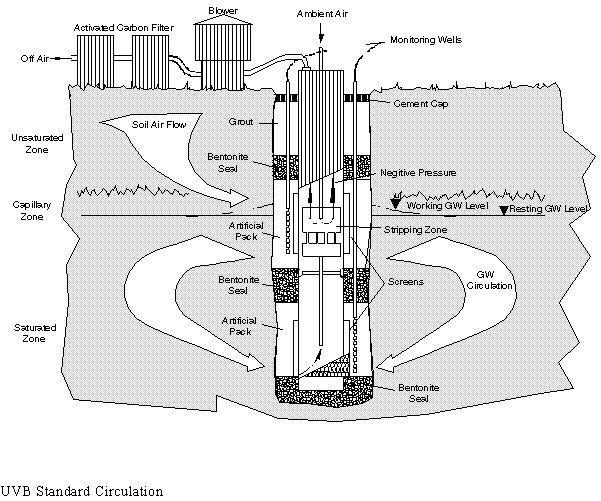
(UVB - Vacuum Vaporizing Well)
The Unterdruck-Verdampfer-Brunnen (UVB) vacuum vaporizing well is an in situ system for remediating contaminated aquifers, especially those contaminated with volatile organic compounds (VOC). The UVB system uses a combination of chemical, physical, and biological processes.
A UVB system consists of a specially adapted groundwater well, a negative pressure stripping reactor, an aboveground mounted blower, and a waste air decontamination system such as activated carbon beds (see figure below).

The water level rises about 1 foot inside the well due to negative pressure generated by a blower. Fresh air is drawn into the system through a pipe leading to the stripping reactor, and passes up through the raised water. The rising air bubbles enhance the suction effect at the bottom of the well, creating air-lift. A specific flow direction can be induced by adding a support pump to produce an upward or downward vertical flow within the well.
The contaminants vaporize into the air bubbles and are removed from the well by the air flow. The oscillating hydraulic pressure forces the water horizontally into the aquifer through the top screened well segment. In the surrounding aquifer, a circulation system develops; water enters at the well base and leaves through the upper screened segment, or vice versa, depending on the desired flow direction.
A flow pattern with a calculable horizontal and vertical component is produced in the aquifer to compensate for the directed water flow within the UVB well. Thus, treated groundwater circulates through the circulation cell within the aquifer before returning to the well.
The UVB technology can extract soil gas during groundwater treatment. The amount of soil gas and groundwater passing through the decontamination system can be adjusted according to the type of contamination and the well construction.
The UVB technology is designed to remove VOCs from groundwater. Depending on the circumstances, the UVB system may also remediate semivolatile organic compounds and heavy metals.
This technology was accepted into the SITE Demonstration Program in 1993. The demonstration at March Air Force Base, California was completed in May 1994. The Demonstration Bulletin (EPA/540/MR-95/500), Technology Capsule (EPA/540/R-95/500a), and Innovative Technology Evaluation Report (EPA/540/R-95/005) are available from EPA.
Demonstration results indicate that the UVB system reduced trichloroethene (TCE) in groundwater by an average of greater than 94 percent. The average TCE concentration from the outlet of the UVB system in the treated groundwater was approximately 3 micrograms per liter (µg/L), with only one event above 5 µg/L. The inlet TCE concentration averaged 40 µg/L.
Results of a dye-tracer study conducted during the demonstration indicated that the radius of the circulation cell was at least 40 feet.
Modeling of the radius of the circulation cell by Roy F. Weston, Inc., suggests that it may extend to approximately 83 feet, which compares to a conventional pumping well radius of influence of 60 feet.
In general, TCE in the shallow and intermediate screened wells showed a concentration reduction both vertically and horizontally during the demonstration. TCE concentrations in these wells appeared to homogenize as indicated by their convergence and stabilization. Variations in TCE concentrations were noted in the deep screened wells.
EPA PROJECT MANAGER:
Michelle Simon
U.S. EPA
National Risk Management Research Laboratory
26 West Martin Luther King Drive
Cincinnati, OH 45268
513-569-7469
Fax: 513-569-7676
TECHNOLOGY DEVELOPER CONTACTS:
Jeff Bannon
Roy F. Weston, Inc.
14724 Ventura Boulevard, Suite 1000
Sherman Oaks, CA 91403
818-971-4900
Fax: 818-971-4901
Eric Klingel
IEG Technologies
5015D West W.T. Harris Boulevard
Charlotte, NC 28269
704-599-4818
Fax: 704-599-4815